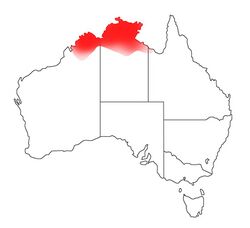Biology:Tetragonula mellipes
| Tetragonula mellipes | |
|---|---|
| Scientific classification | |
| Domain: | Eukaryota |
| Kingdom: | Animalia |
| Phylum: | Arthropoda |
| Class: | Insecta |
| Order: | Hymenoptera |
| Family: | Apidae |
| Genus: | Tetragonula |
| Species: | T. mellipes
|
| Binomial name | |
| Tetragonula mellipes Friese, 1898
| |

| |
| Map showing the estimated current distribution of T. mellipes in Australia | |
| Synonyms | |
| |
Tetragonula mellipes is a small eusocial stingless bee first described by Friese in 1898[1] and it is found in Northern Australia (Northern areas of Western Australia and Northern Territory).[2]
Description and identification
The workers (3.6-4.3mm) are pale brown with sides of the thorax (Mesopleuron and metapleuron) densely and evenly covered with fine, short hair. Male drone body colour is very similar to the workers.[2] T. mellipes is distinctly smaller than the sympatric T. hockingsi in most characters. However, it is similar to the apparently allopatric T. carbonaria, except it has shorter wings.[2] Furthermore, when alive, the eyes are paler in colour compared to the darker eyes of T. carbonaria and T. hockingsi.
Nest building
The nests of T. mellipes are irregular and small.[3] T. mellipes can be found nesting in small cavities inside trees and stone walls. It has a semi-comb arrangement of brood. The brood is also smaller, typically being less than half a litre compared with the average 2 litres of its relatives.[4] Most T. mellipes nests have external entrance tunnels and some nests may have more than one entrance (up to four).[2]
References
- ↑ Friese, H. (1898). "Die Trigona-Arten Australiens". Természetrajzi Füzetek 21 (3–4): 427–431. https://scholar.google.com/scholar?hl=en&as_sdt=0%2C5&q=Friese+1898+die+trigona+arten+australiens&btnG=#d=gs_cit&u=%2Fscholar%3Fq%3Dinfo%3AvCMkXOUV0aAJ%3Ascholar.google.com%2F%26output%3Dcite%26scirp%3D0%26hl%3Den.
- ↑ 2.0 2.1 2.2 2.3 Dollin, Anne E.; Dollin, Leslie J.; Sakagami, the late Shôichi F. (1997). "Australian stingless bees of the genus Trigona (Hymenoptera: Apidae)". Invertebrate Systematics 11 (6): 861. doi:10.1071/it96020. ISSN 1445-5226. http://dx.doi.org/10.1071/it96020.
- ↑ Dollin, Anne (2012). "Exploring Western Australia". https://www.aussiebee.com.au/aussiebeeonline019.pdf.
- ↑ Heard, Tim (2016). The Australian native bee book : keeping stingless bee hives for pets, pollination and sugarbag honey. West End, Brisbane, Qld. ISBN 978-0-646-93997-1. OCLC 910915206. https://www.worldcat.org/oclc/910915206.
Wikidata ☰ Q2282506 entry
 |

